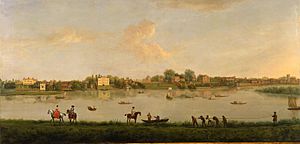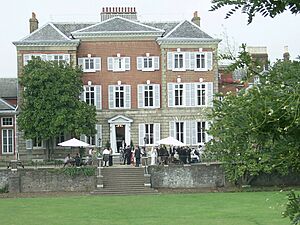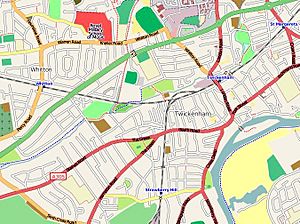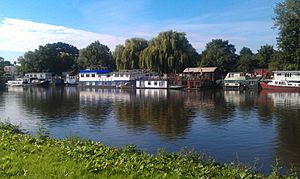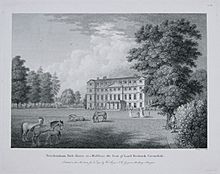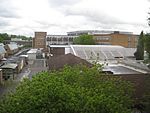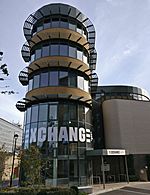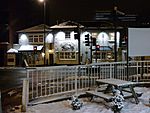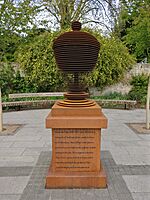Twickenham facts for kids
Quick facts for kids Twickenham |
|
|---|---|
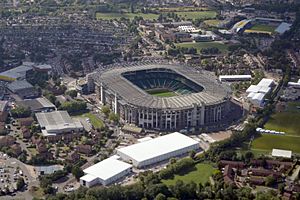 Aerial view of Twickenham Stadium (centre) and Stoop Stadium (background) from the north in August 2015 |
|
| Area | 12.36 km2 (4.77 sq mi) |
| Population | 62,148 (2011 Census) |
| • Density | 5,028/km2 (13,020/sq mi) |
| OS grid reference | TQ1673 |
| • Charing Cross | 9.9 mi (15.9 km) NE |
| London borough | |
| Ceremonial county | Greater London |
| Region | |
| Country | England |
| Sovereign state | United Kingdom |
| Post town | TWICKENHAM |
| Postcode district | TW1, TW2 |
| Dialling code | 020 |
| Police | Metropolitan |
| Fire | London |
| Ambulance | London |
| EU Parliament | London |
| UK Parliament |
|
| London Assembly |
|
Twickenham is a lively area in London, England. It sits right by the beautiful River Thames. This area is about 16 kilometers (9.9 miles) southwest of central London.
Twickenham has been part of the London Borough of Richmond upon Thames since 1965. The main offices for the local council are here. In 2011, about 62,148 people lived in Twickenham, including the nearby areas of St Margarets and Whitton.
Twickenham is super famous for rugby! It's home to the Rugby Football Union. Thousands of fans visit Twickenham Stadium every year. The historic riverside has many old buildings and lovely gardens from the 1700s.
You can also find three amazing old houses here that are open to the public. These are York House, Marble Hill, and Strawberry Hill House. Another famous house belonged to the poet Alexander Pope. He was known as the Bard of Twickenham. Strawberry Hill House, a unique Gothic-style home, is connected to St Mary's University, Twickenham. This is the oldest Roman Catholic university in England.
Contents
- History of Twickenham
- How Twickenham is Governed
- Twickenham's Economy
- Population and Homes in Twickenham
- Geography of Twickenham
- Education in Twickenham
- Transport in Twickenham
- Sports in Twickenham
- Arts and Culture in Twickenham
- Public Art in Twickenham
- Places of Worship in Twickenham
- Famous People from Twickenham
- See also
History of Twickenham
How Old is Twickenham?
People have lived in the Twickenham area for a very long time. Digs have found signs of settlements from the Early Neolithic period. This was a time when people started farming. People continued to live here through the Bronze Age, Iron Age, and when the Romans were in Britain.
The name "Twickenham" was first written down in the 700s. It was called "Tuican hom" or "Tuiccanham." This was in a special paper that gave the land to the Bishop of London.
Twickenham in Norman Times
After the Normans took over England in 1066, Twickenham became part of a large estate. This estate was called the Manor of Isleworth. The land was mostly used for farming for hundreds of years. The river was also important for fishing, building boats, and trading goods.
Twickenham in the 1600s
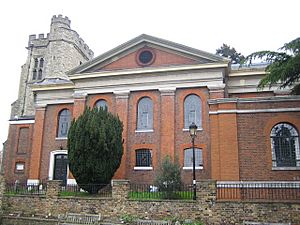
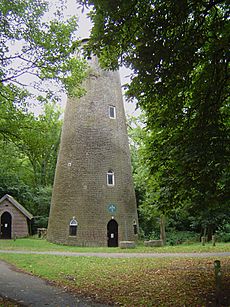

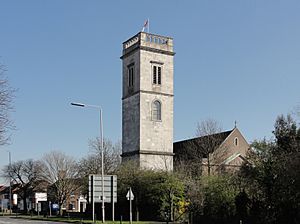
In 1665, a serious illness called the Bubonic plague reached Twickenham. Sadly, 67 people died. The town also had a special "watch house" back then. This was a place where guards kept an eye on things. It had stocks and a pillory to punish people who broke rules.
Building started on York House in 1633. Important people lived there, like Edward Montagu and Edward Hyde. The first mention of the Twickenham Ferry was in 1659. But people had been using ferries to cross the river for many years before that.
Twickenham in the 1700s
In 1713, part of the old St Mary's Church fell down. It was rebuilt in a new style by a local architect named John James.
In 1736, a doctor named Joshua Ward opened a factory here. It made sulfuric acid, which smelled very bad. This made local people unhappy. Twickenham also became home to the world's first factory for making gunpowder. This factory was located near the River Crane. There were often explosions, and sometimes people were hurt. In 1772, three mills exploded. This broke windows and damaged buildings nearby.
The gunpowder mills stayed open until 1927. Today, much of the area is a park called Crane Park. You can still see parts of the old Shot Tower and other factory remains. The area near the Shot Tower is now a nature reserve.
Twickenham's Later Development
In 1818, new roads were built, and more land was developed. Many beautiful houses were built in the 1700s and 1800s. Twickenham became a popular place for important and fashionable people to live. When the train station opened in 1848, it helped the area grow even more.
Electricity came to Twickenham in 1902. The first trams arrived the next year. In 1939, a church from the City of London was taken down. Its famous stone tower and other parts were moved to Twickenham. They were used to build the new All Hallows Church near Twickenham Stadium.
How Twickenham is Governed
Twickenham has been managed by different local councils over the years. In 1926, it became a "municipal borough." This meant it had its own local government. Later, in 1937, other nearby areas joined with Twickenham.
In 1965, Twickenham joined with Richmond and Barnes. They formed the London Borough of Richmond upon Thames. This is the local council that runs things today. The main offices for the council are at York House, Twickenham.
Twickenham also has a Member of Parliament (MP) who represents the area in the UK Parliament. Since 2019, the MP for Twickenham has been Munira Wilson.
Twickenham's Economy
Many people who live in Twickenham travel to central London for work. Others work locally in shops, restaurants, schools, or for businesses in the area. London Heathrow Airport is also important for jobs.
The local council has been working to improve Twickenham town centre. It faces competition from bigger shopping areas nearby. Twickenham has more cafes, restaurants, and banks than typical shops. The council has made many improvements, like new paving and a better riverside walk.
Population and Homes in Twickenham
We have information about how many people have lived in Twickenham since 1891. In 2011, there were 62,148 people living in 22,273 homes.
| Year | 1901 | 1911 | 1921 | 1931 |
|---|---|---|---|---|
| Population | 20,991 | 29,367 | 34,790 | 39,906 |
The 2011 census also tells us about the types of homes. Most people in Twickenham are White British. Other large groups include people of Other White, White Irish, and Indian backgrounds.
Geography of Twickenham
Twickenham is next to the River Thames on its south side. The land is mostly flat but rises slightly to the west. The soil is good for growing things. In the past, there were many market gardens here. But now, houses are the main feature.
The town is bordered by the River Thames and Eel Pie Island. You can walk to Eel Pie Island using a narrow footbridge. Before 1957, people used a hand-operated ferry to get there. The land along the river has fancy homes, gardens, pubs, and a new park.
In the south, in Strawberry Hill, you'll find St Mary's University, Twickenham. This university is known for sports, teaching, and arts. Strawberry Hill House was originally a small house. Horace Walpole bought it in 1747 and turned it into a famous Gothic-style building.
The poet Alexander Pope also had a villa and garden nearby. His villa was taken down in 1808. But his special underground cave, called a grotto, still exists! A plaque was put up in 1848 to remember his home. A road nearby is called Pope's Grove. There's also a pub called the Alexander Pope Hotel where his garden used to be.
Twickenham has many beautiful houses, especially from the Victorian era. A park called Radnor Gardens is near Pope's Grotto. Close by is the Roman Catholic Church of Saint James. It has a special window and memorials for Manuel II, Portugal's last king, who lived and died nearby.
The areas of East Twickenham and St Margarets are to the northeast. They are popular for their pretty, tree-lined streets and many shops and cafes. Twickenham Studios, a major film studio, is in St Margarets.
Nearby Places to Twickenham
- Whitton
- Richmond
- East Twickenham/St Margarets
- Fulwell
- Teddington
- Hampton
- Isleworth
- Hampton Hill
- Feltham
- Ham
- Hampton Wick
- Kingston upon Thames
Education in Twickenham
Twickenham has a university and many schools. These include secondary schools, primary schools, and kindergartens. Local buses make it easy to get to them.
Richmond upon Thames College is a college for further and higher education. It is located on Egerton Road. St Mary's University, Twickenham moved to Twickenham in 1925 and has been here ever since.
Transport in Twickenham
Twickenham has good transport links. There used to be a bus depot here until 1971. Now, buses are based at the Fulwell garage. This garage was originally for trams. Later, trolleybuses operated from here.
The main train station is Twickenham. Other nearby stations include St Margarets, Whitton, Fulwell, and Strawberry Hill.
Nearest Train Stations
- Twickenham
- St Margarets
- Whitton
- Fulwell
- Strawberry Hill
- Hampton
- Hampton Wick railway station
- Isleworth railway station
- Richmond
- Teddington railway station
Bus Routes in Twickenham
Many London Buses serve Twickenham. Most of these routes go through King Street in the town centre. Some routes, like the 110 and 481, go through other parts of Twickenham. There are also night buses, like the N22 and N33, that run from midnight to 5 AM.
| Route | Start | End | Operator |
| 33 | Fulwell station | Castelnau | London United |
| 110 | Hounslow bus station | Hammersmith bus station | London United |
| 267 | Fulwell bus garage | Hammersmith bus station | London United |
| 281 | Hounslow bus station | Tolworth | London United |
| 290 | Twickenham | Staines | Transport UK London Bus |
| 481 | Kingston | West Middlesex University Hospital | Transport UK London Bus |
| 490 | Heathrow Terminal 5 | Richmond | Transport UK London Bus |
| H22 | Hounslow | West Middlesex University Hospital | London United |
| R68 | Kew Retail Park | Hampton Court | Transport UK London Bus |
| R70 | Hampton | Richmond | Transport UK London Bus |
| N22 | Oxford Circus | Fulwell | London General |
| N33 | Fulwell station | Hammersmith bus station | London United |
Sports in Twickenham
Twickenham is famous for rugby! It's where the Rugby Football Union has its main office. Twickenham Stadium is one of England's biggest sports stadiums. It's the largest rugby stadium in the world. The England national rugby union team plays all its home games here.
Another rugby club, Harlequins, plays at the Twickenham Stoop. Twickenham Stadium has hosted many big Rugby World Cup games. This includes the finals in 1991 and 2015.
Arts and Culture in Twickenham
The Exchange is a community building near Twickenham train station. It has a theatre with 320 seats. It opened in 2017. St Mary's University, Twickenham manages this building.
The Twickenham Museum is run by volunteers. It's across from St Mary's parish church. You can visit it every day except Mondays. The Cabbage Patch pub is a popular spot for live music. Since 1983, it has hosted music nights on Sundays.
Public Art in Twickenham
In 2015, a special piece of public art was put on the Twickenham riverside. It's called Pope's Urn. It was inspired by the poems of Alexander Pope. This sculpture was created to celebrate the 2015 Rugby World Cup. It was officially opened in September 2015.
Places of Worship in Twickenham
Twickenham has many different churches and places of worship. Here are some of them:
| Name | Type of Church | Address | Website | Image |
|---|---|---|---|---|
| All Hallows | Church of England | 138 Chertsey Road, Twickenham TW1 1EW | website |  |
| All Saints | Church of England | Campbell Road, Twickenham TW2 5BY | website | |
| Amyand Park Chapel | Reformed Baptist | 174 Amyand Park Road, Twickenham TW1 3HY | website |  |
| Free Grace Baptist | Grace Baptist | Powdermill Lane, Twickenham TW2 6EJ | website | |
| Holy Trinity | Church of England | 1 Vicarage Road, Twickenham TW2 5TS | website |  |
| St James | Roman Catholic | 61 Pope's Grove, Twickenham TW1 4JZ | website | |
| St Mary's | Church of England | Church Street, Twickenham TW1 3NJ | website |  |
| St Stephen's | Church of England | Richmond Road, East Twickenham TW1 2PD | website | 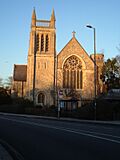 |
| Salvation Army | Salvation Army | May Road, Twickenham TW2 6QP | website | |
| Methodist | Methodist | Queen's Road, Twickenham TW1 4EN | website | 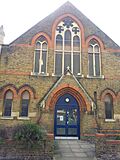 |
| United Reformed | United Reformed Church | First Cross Road, Twickenham TW2 5QA | website |
Famous People from Twickenham
Many interesting people have lived in Twickenham over the years.
People Living Today
- Steve Allen, a radio host, lives here.
- Jason Bradbury, a children's writer and TV presenter, lives in Twickenham.
- Rob Brydon, a comedian, lives in Strawberry Hill.
- Michael Fish, a TV weather forecaster, lives in Twickenham.
- Keeley Hawes and Matthew Macfadyen, both actors, live in Twickenham.
- Roxanna Panufnik, a composer, grew up in a house by the Thames.
- Pete Townshend, the guitarist from The Who, used to live at 15 Montpelier Row.
Historical Figures
- Trevor Baylis (1937–2018), who invented the clockwork radio, lived and worked on Eel Pie Island.
- Kitty Clive (1711–1785), a famous actress, retired to a villa in Twickenham.
- Walter de la Mare (1873–1956), a poet, lived in Montpelier Row until he passed away.
- William Goode (1907–1986), who was the first leader of Singapore, was born in Twickenham.
- Ron Greenwood (1921–2006), a famous football manager, lived here early in his career.
- Norman Cyril Jackson (1919–1994), an RAF sergeant who won a very brave award, is buried in Twickenham Cemetery.
- Sir Godfrey Kneller, 1st Baronet (1646–1723), a portrait painter, helped rebuild St Mary's, Twickenham church.
- Charles Lightoller (1874–1952), the highest-ranking officer to survive the Titanic sinking, lived in East Twickenham.
- King Manuel II of Portugal (1874–1952) lived in exile at Fulwell Park in Twickenham.
- Andrzej Panufnik (1914–1991), a Polish composer, lived and died by the Twickenham riverside.
- Alexander Pope (1688–1744), a famous poet, lived in Twickenham. He was known as the Bard of Twickenham.
- Peter Sallis (1921–2017), the actor who voiced Wallace in Wallace and Gromit, was born in Twickenham.
- Sir Ratan Tata (1871–1918), a big industrialist from India, owned York House, Twickenham.
- Alfred, Lord Tennyson (1809–1892), a famous author and poet, lived at 15 Montpelier Row. His son was born there.
- J. M. W. Turner (1775–1851), a famous artist, designed and built his home, Sandycombe Lodge, here.
- Thomas Twining (1675–1741), who started the Twinings tea company, lived next to St Mary's, Twickenham church.
- Horace Walpole (1717–1797), a writer and politician, built and lived at Strawberry Hill House.
See also
 In Spanish: Twickenham para niños
In Spanish: Twickenham para niños



